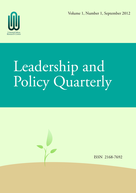


Volume 11 Issues 1-4 (2022-12-31)
Volume 10 Issues 1-4 (2021-12-31)
Volume 9 Issues 1-3 (2020-09-30)
Volume 8 Issues 3&4 (2019-12-31)
Volume 7 Issues 1&2 (2018-06-30)
Volume 6 Issues 3&4 (2017-12-31)
Volume 6 Issues 1&2 (2017-06-30)
Volume 5 Issues 3&4 (2016-12-31)
Volume 5 Issues 1&2 (2016-06-30)
Volume 4 Issues 3&4 (2015-12-31)
Local government and the state more broadly is often accused of being bureaucratic, inflexible and unresponsive. Indeed, the public sector is often positioned as the antithesis to entrepreneurial endeavors. Yet, some local governments have a distinguished track-record of entrepreneurial initiates, although experience is highly differentiated and context-contingent. Against a backdrop of global economic turbulence and austerian politics in some countries such as Spain and the US, some local governments are seeking to undertake an entrepreneurialization of services, of which sponsorship is one important repertoire amongst numerous others. Engaging with a diverse body of research studies, from different disciplinary fields, this chapter critically reviews some innovative approaches to sponsorship with a particular focus on financial aspects, institutional factors and stakeholder relationships. Firstly, discrete forms of sponsorship are analyzed to help arrive at a more nuanced understanding of sponsorship than many actors, especially policymakers, may currently comprehend. Secondly, the potentialities, limitations and contradictions are examined. The chapter is framed by a theoretically situated account of neoliberal urban mutations and a critical reading of the entrepreneurialization of public services. It concludes by outlining the contextual apparatus that local authorities may wish to consider before embarking on sponsorship activities in the hope of providing the ‘silver bullet’ for fiscal stresses. Critical contextual considerations are expressed by the 3 C’s model referring to clarity of mission, communication and capacity.
This article assembles together many social and educational ranking results of eight East Asian countries as a frame of reference to compare Hong Kong and Singapore on the various aspects covered. In a broader sense, there were more similarities than differences between the two cities, since they were on par with each other on more than half of the 26 comparisons besides their geographical-political resemblance. Specifically, Singapore was a country less masculine, less concerned with certainty, and less traditional, her people was happier, her environment was less exploited, there was a lower degree of corruption, her best university was more favorably evaluated, and her primary school children achieved better in Science. These findings were briefly discussed with reference to the physical, historical, and political developments of the two cities. Hong Kong appeared to take the lead in many aspects in the last century, but lags behind gradually in the new century.